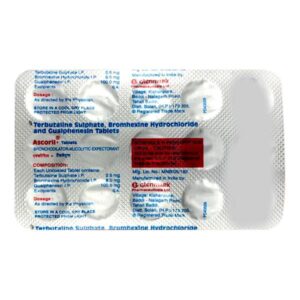TERBUTALINE + BROMHEXINE + GUAIPHENESIN
Terbutaline: Terbutaline is a medication primarily used to treat bronchospasm in conditions like asthma, chronic obstructive pulmonary disease (COPD), and bronchitis. It belongs to a class of drugs called beta-2 adrenergic agonists, and its main mechanism of action is the relaxation of smooth muscles in the airways, resulting in bronchodilation and improved airflow.
This drug is available in various forms such as tablets, oral syrup, and inhalers. The dose and frequency of administration may vary depending on the individual’s age, condition, and severity. For oral tablets, the typical starting dose for adults is 2.5 mg three times a day, with a maximum dose of 10 mg every 4-6 hours. The oral syrup is usually taken in doses of 1-2 teaspoons every 6-8 hours.
Inhalation therapy with terbutaline is commonly done using a metered-dose inhaler (MDI) or a nebulizer. The typical recommended dose for adults using an MDI is 2 inhalations (0.25 mg each) every 4-6 hours as needed, while the nebulizer dose is 5 mg every 6-8 hours.
Some common side effects of terbutaline include headache, tremor, nervousness, dizziness, rapid heart rate (tachycardia), palpitations, and muscle cramps. These effects are usually mild and transient. However, high doses or prolonged use can lead to more serious side effects such as increased blood pressure, cardiac arrhythmias, and hypokalemia (low potassium levels).
It is important to note that terbutaline should not be used as a first-line therapy for asthma, and it is usually reserved for cases where other medications, such as short-acting beta-agonists, are insufficient. Pregnant women should avoid terbutaline as it has been associated with potential risks to the fetus. Furthermore, terbutaline should be used with caution in individuals with underlying cardiovascular conditions, such as heart disease or arrhythmias.
As with any medication, it is essential to follow the prescribed dose and consult with a healthcare professional for personalized advice and guidance regarding the use of terbutaline.
Bromhexine: Bromhexine is a medication used to treat respiratory conditions such as bronchitis, asthma, and other respiratory disorders associated with excessive mucus production. It is an expectorant, which means it helps to thin and loosen mucus in the airways, making it easier to cough up.
The main active ingredient in Bromhexine is bromhexine hydrochloride. It works by increasing the production of fluid in the respiratory tract, which helps to break down and thin the mucus, making it easier to expel.
The typical recommended dose of Bromhexine is:
– For adults and children over 14 years: 8-16 mg, three times a day.
– For children aged 6-14 years: 4-8 mg, three times a day.
– For children aged 2-6 years: 2-4 mg, three times a day.
– For children under 2 years: The use of Bromhexine is not recommended in this age group.
It is important to follow the specific dosage instructions provided by your healthcare provider or as mentioned on the medication packaging.
Common side effects of Bromhexine may include nausea, stomach discomfort, vomiting, diarrhea, headache, and skin rashes. If any of these side effects persist or worsen, it is advisable to seek medical attention. Additionally, some rare but serious side effects may occur, such as allergic reactions, difficulty breathing, chest pain, or swelling of the face, lips, tongue, or throat. In such cases, immediate medical assistance should be sought.
Please note that this is a general overview of Bromhexine, and specific recommendations may vary depending on the individual and their medical condition. It is always advisable to consult with a healthcare professional before starting any medication.
Guaiphenesin: Guaifenesin is an expectorant drug that is commonly used to relieve cough and congestion associated with respiratory conditions such as the common cold, bronchitis, and sinusitis. It works by thinning and loosening mucus in the airways, making it easier to cough up and expel.
Guaifenesin’s mechanism of action is not fully understood. However, it is thought to work by increasing the volume and reducing the viscosity of respiratory tract secretions. This helps to promote the clearance of mucus and alleviate congestion.
The usual recommended dose of guaifenesin for adults and children over 12 years old is 200-400mg every 4 hours, with a maximum daily dose of 2.4 grams. For children aged 6-12 years, the usual dose is 100-200mg every 4 hours, with a maximum daily dose of 1.2 grams. It is important to follow the instructions on the product label or as directed by a healthcare professional.
Common side effects of guaifenesin include dizziness, drowsiness, nausea, vomiting, headache, diarrhea, and stomach upset. These side effects are generally mild and temporary. However, if any severe or persistent side effects occur, it is recommended to consult a healthcare professional.
It is worth noting that guaifenesin may interact with certain medications, such as expectorants containing codeine or dextromethorphan. It is always important to inform your healthcare provider about all the medications you are taking to avoid any potential drug interactions.
Overall, guaifenesin is a widely used and generally well-tolerated expectorant medication that can help relieve symptoms of cough and congestion associated with respiratory conditions. However, it is always advisable to consult a healthcare professional for proper diagnosis and appropriate use of this drug.

